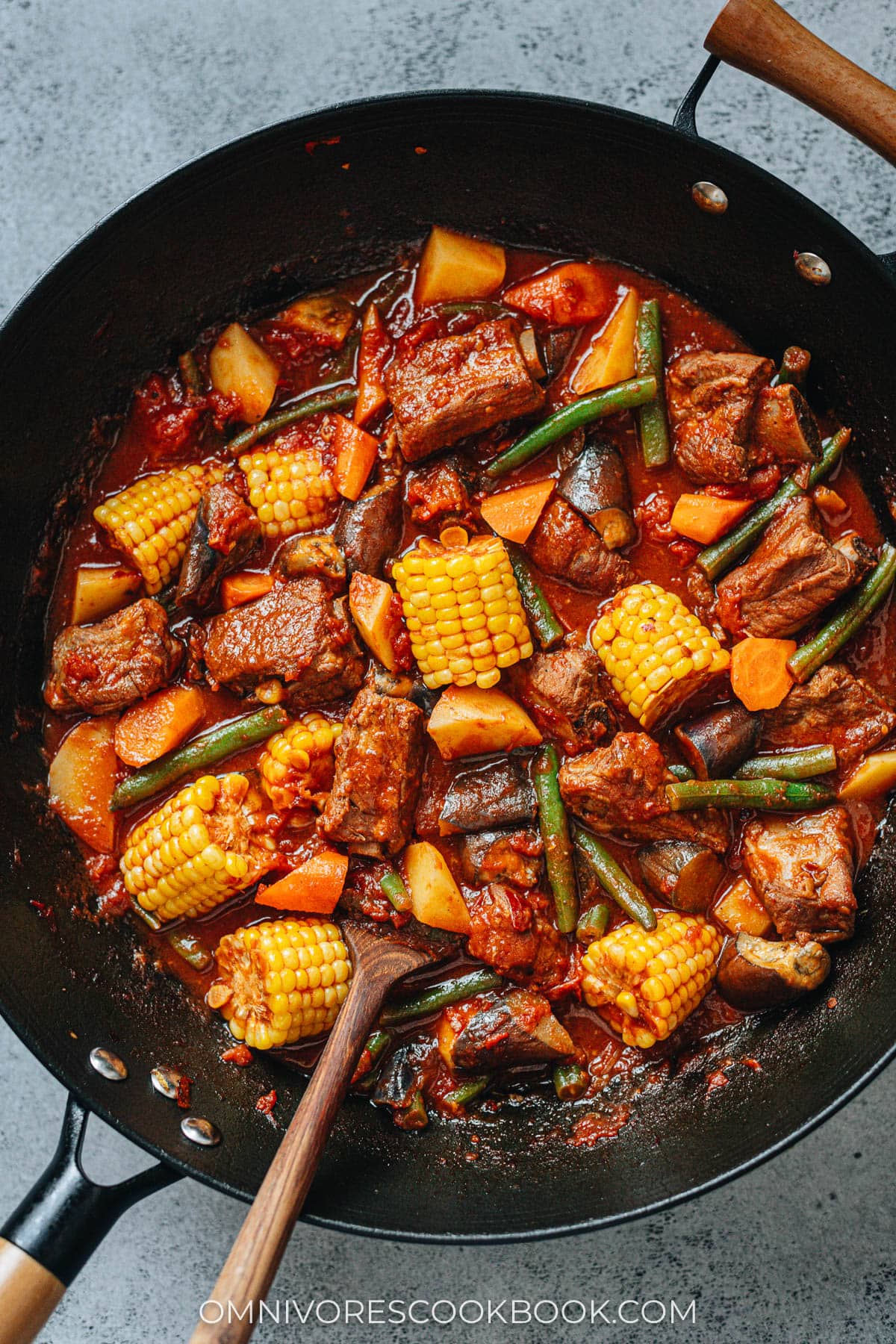
An introduction to Chinese pork and vegetable stew
Pork and vegetable stew, or Luan Dun (乱炖) is a traditional northeastern Chinese stew known for its hearty, rustic nature. “Luan Dun” translates to “mixed stew” or “randomly stewed,” which highlights its key feature—an assortment of ingredients thrown together and slowly stewed.
Luan Dun represents the harvest. The dish typically includes pork and various vegetables such as potatoes, carrots, cabbage, eggplant, tomatoes, and green beans. The ingredients can vary based on what you have on hand, but the dish is always hearty and filling.
All ingredients are stewed together in a single pot with a savory broth. The seasonings are simple, often including soy sauce, star anise, and scallions, allowing the natural flavor of the ingredients to shine.
The Dongbei region covers the three northeastern provinces of China that border Russia. Food there always comes in big portions. The cooking emphasizes simplicity, designed to be warm, nutritious, and packed with calories to sustain people during the harsh winters.
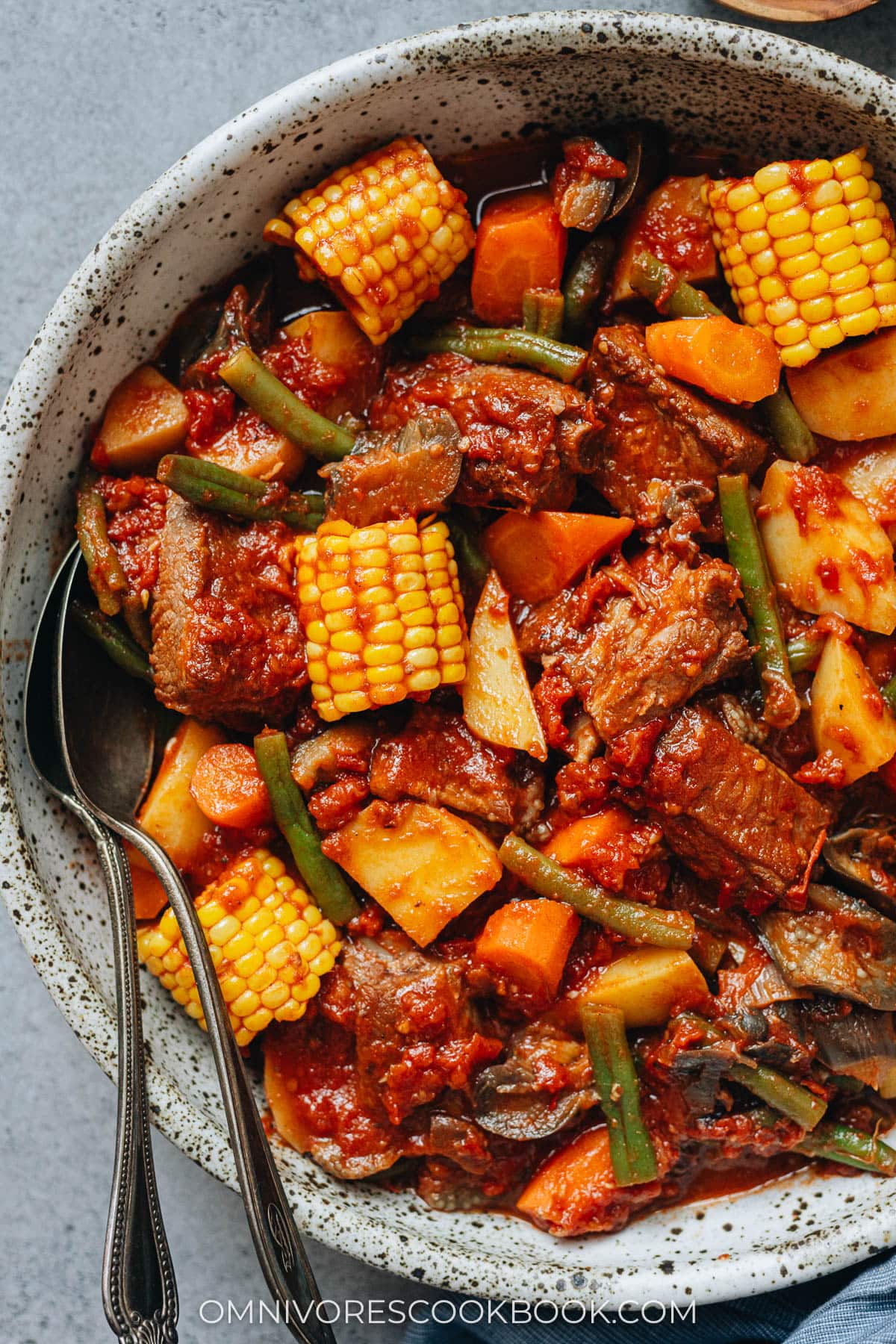
Pork and vegetable stew ingredients
Pork and vegetable stew is a comforting, homestyle dish often made in large portions to serve to family and friends. Each household has its own version with slight variations based on personal taste and ingredient availability.
My recipe is a slightly more elevated version than the typical homestyle version, based on the dish I’ve had countless times in restaurants in Beijing.
Which cut of pork to use
Any pork cut that is suitable for stew can be used in the pork and vegetable stew. In China, pork ribs and pork belly are the most popular options, because both create a delicious broth. Other cuts such as pork shoulder (butt) and pork shank work very well too.
I used short pork ribs, which you can find in most Chinese markets. The short ribs take less time to cook and are sized similarly with the vegetables. But if you can only find regular slabs of ribs, you can use baby back ribs and cut them into single riblets.
The seasonings
There are many ways to season pork and vegetable stew, most of them soy sauce based.
My recipes uses:
- Aromatics: scallion and garlic
- Spices: star anise and cinnamon stick for a warm taste
- Soy sauce and sugar for the base
- Chicken broth
- Doubanjiang: for a spicy kick and fermented umami
Doubanjiang is a key ingredient in Mapo Tofu. It is a salty spicy fermented paste that is full of umami. I like to use it in my pork and vegetable stew because it adds so much flavor to the dish.
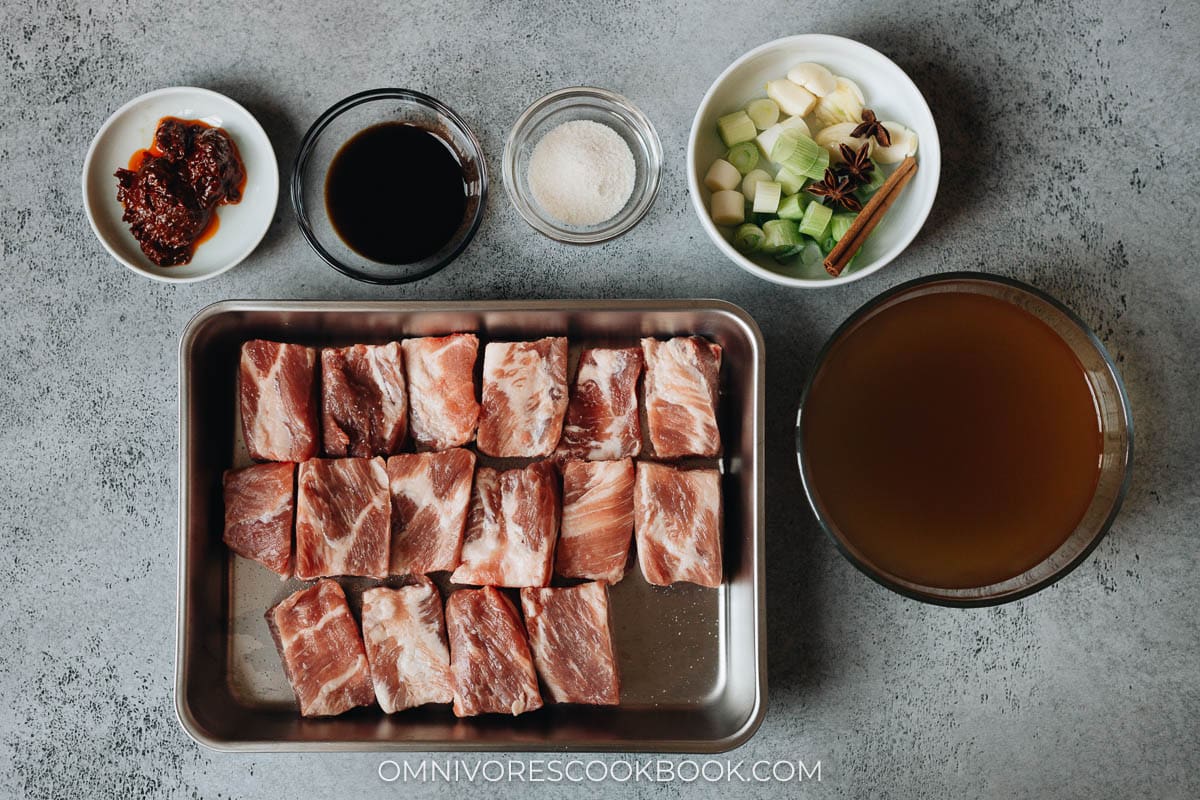
How to make the dish not spicy?
If you prefer not to use Doubanjiang, you can experiment with oyster sauce, Tian Mian Jiang (Sweet Bean Sauce), or more soy sauce.
The vegetables
There are so many vegetables you can add to your pork and vegetable stew. I used some of the most popular ones in my recipe, including:
- Potato
- Carrot
- Green beans
- Corn on the cob
- Eggplant
- Tomato
Most pork and vegetable stews use cut up fresh tomatoes as part of the veggie section. But in this recipe I chose to use canned tomato as a part of the base. I did this to create a more flavorful base without using too much salt.
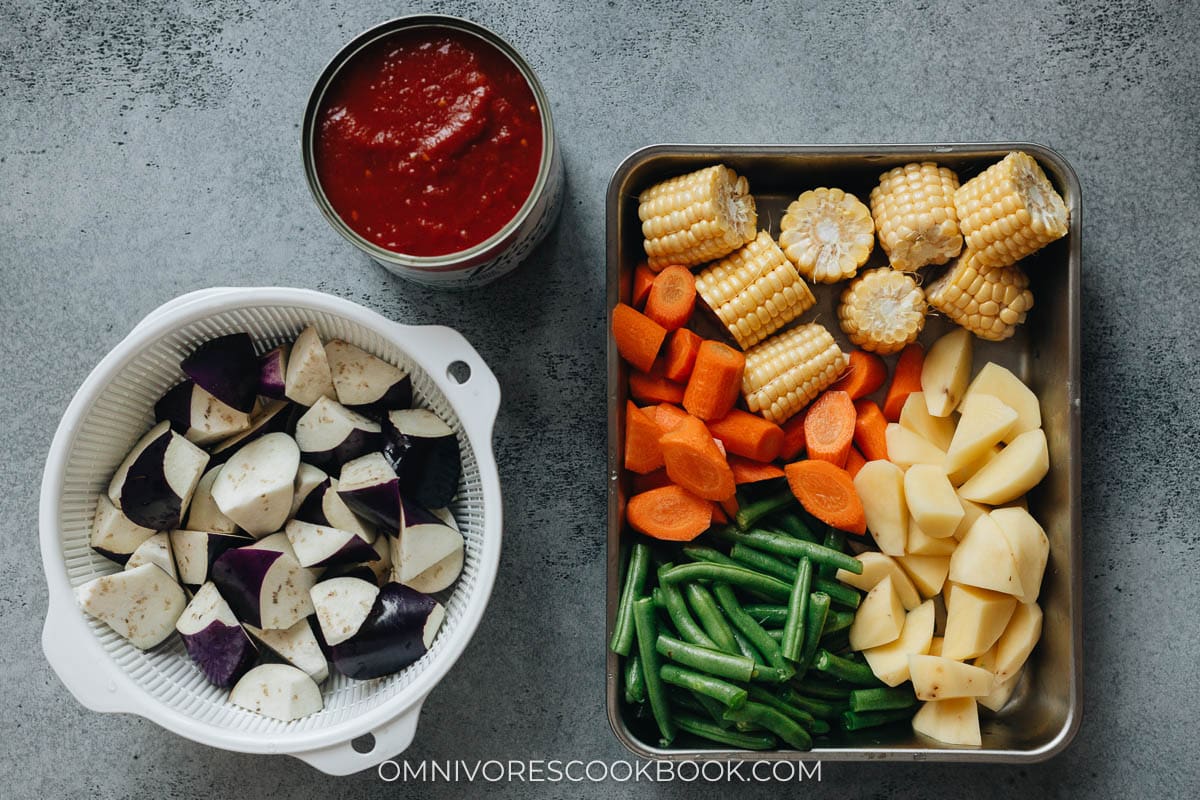
Other vegetable alternatives
I also recommend using napa cabbage, pumpkin or other winter squash, mushrooms, and cabbage. These harder vegetables are great because they will hold their shape during cooking and won’t overcook easily. If you decide to use tender vegetables like bok choy, you should add them during the last 5 minutes of cooking to prevent overcooking.
How to make pork and vegetable stew
Making pork and vegetable stew requires a bit of time but it’s quite hands-off once you start cooking.
First, brown the pork ribs.
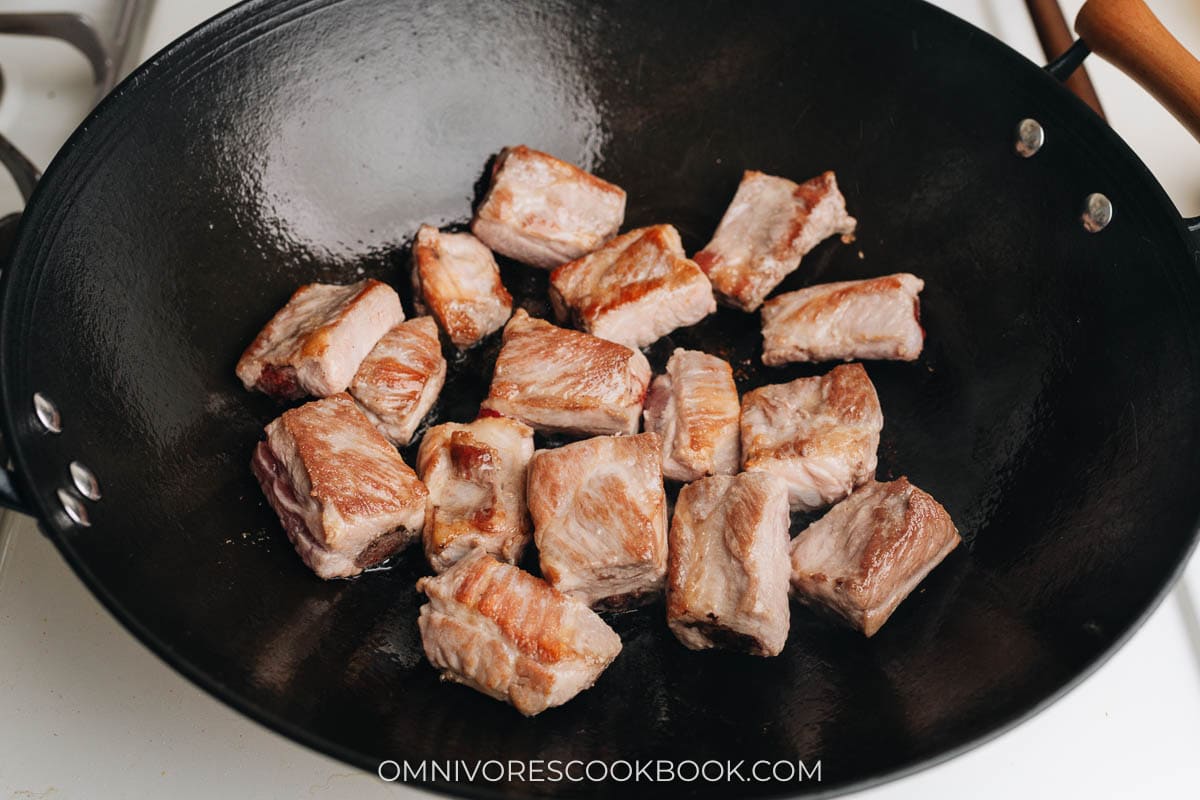
Then add the aromatics and spices. Stir and cook to release fragrance. Then add the Doubanjiang and gently toast it. Pour in Shaoxing wine to deglaze the pan.
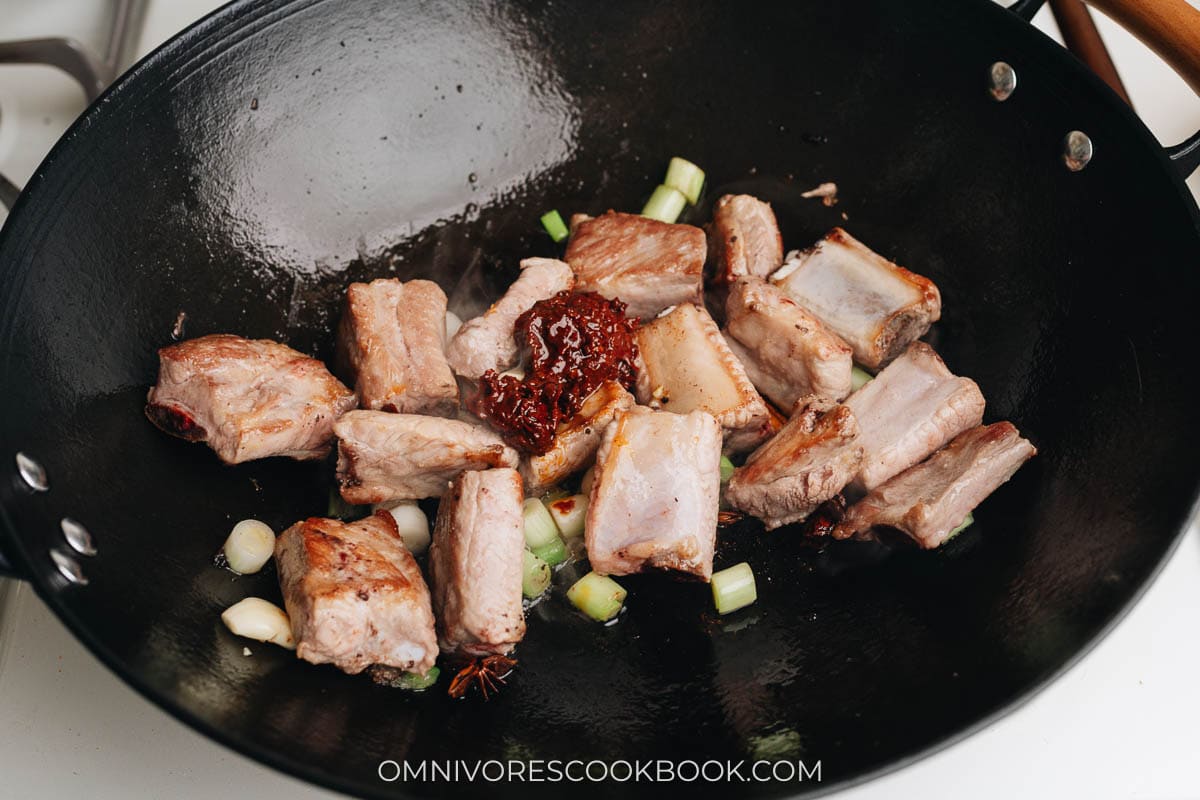
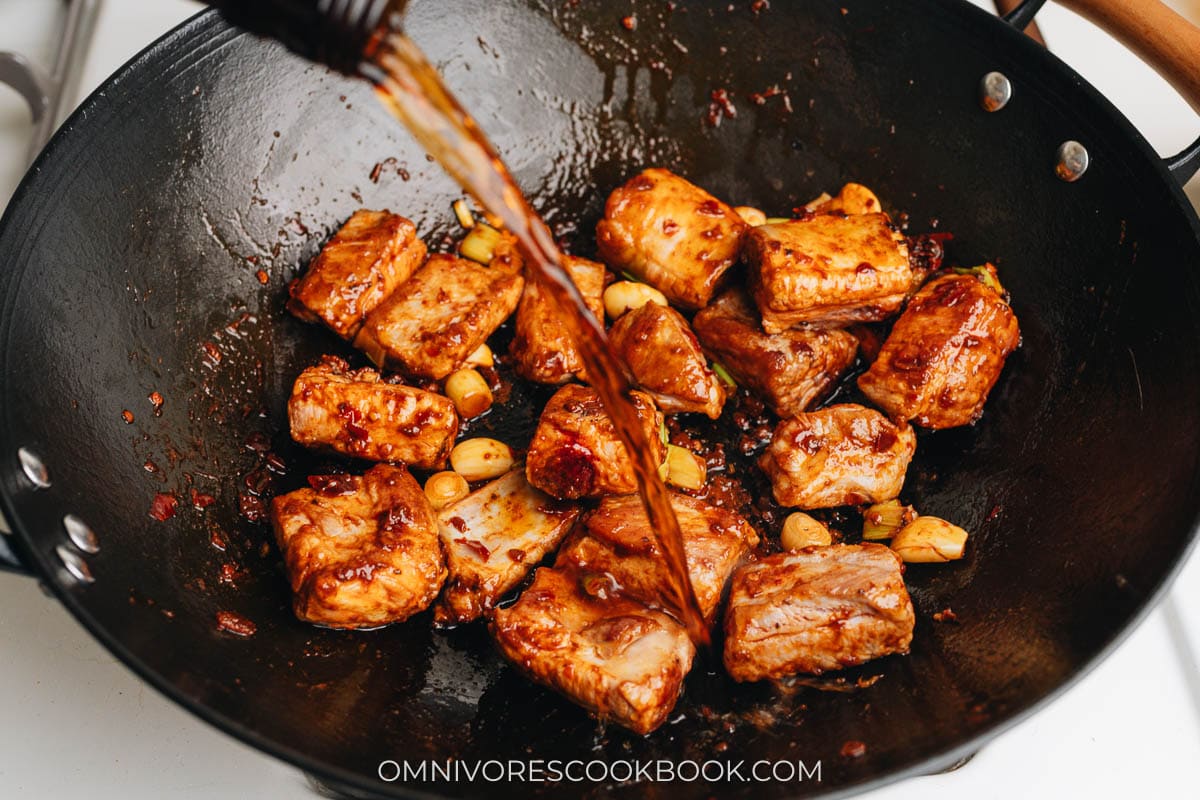
Add the chicken broth, soy sauce and sugar. Bring to a simmer then cook covered until pork is tender, 1 hour or so.
Then add all the vegetables and the canned tomato. Let steam, covered, for 5 minutes. At this point, it will look like the vegetables are not covered in the broth. But no worries. After 5 minutes, the vegetables will release a lot of juice and surmerge all the ingredients.
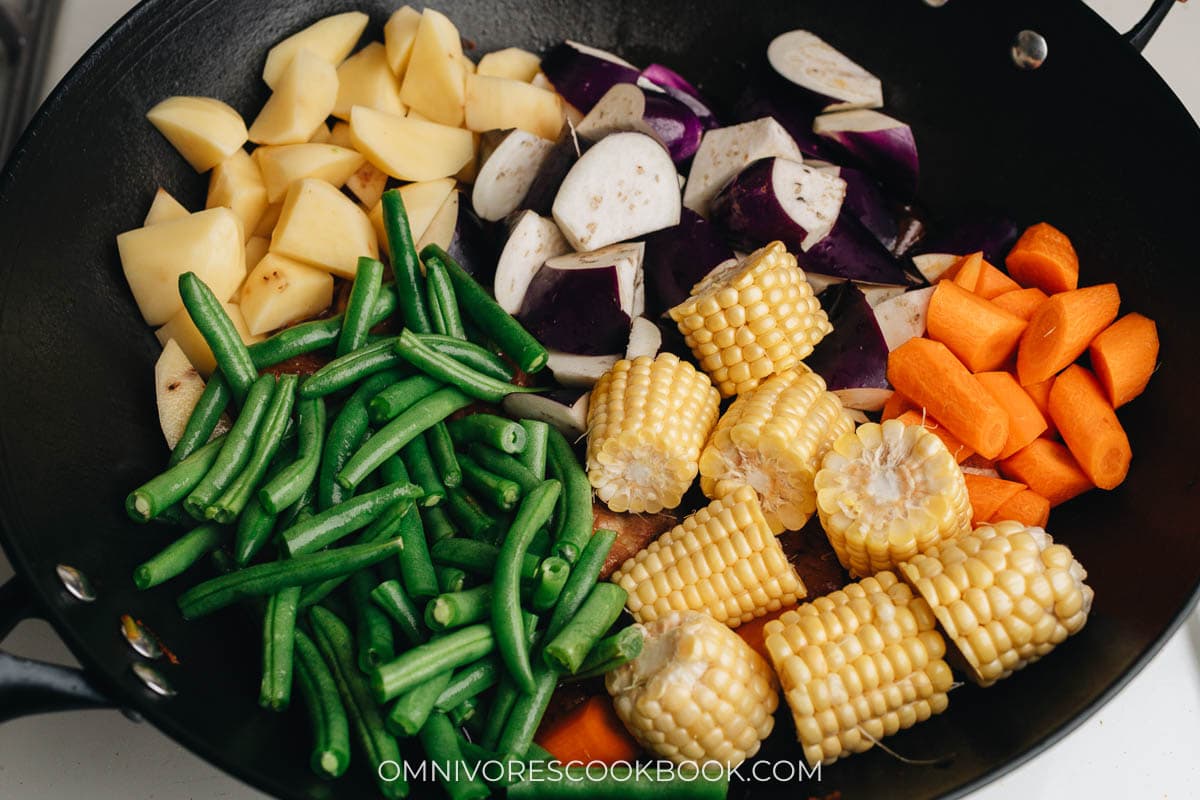
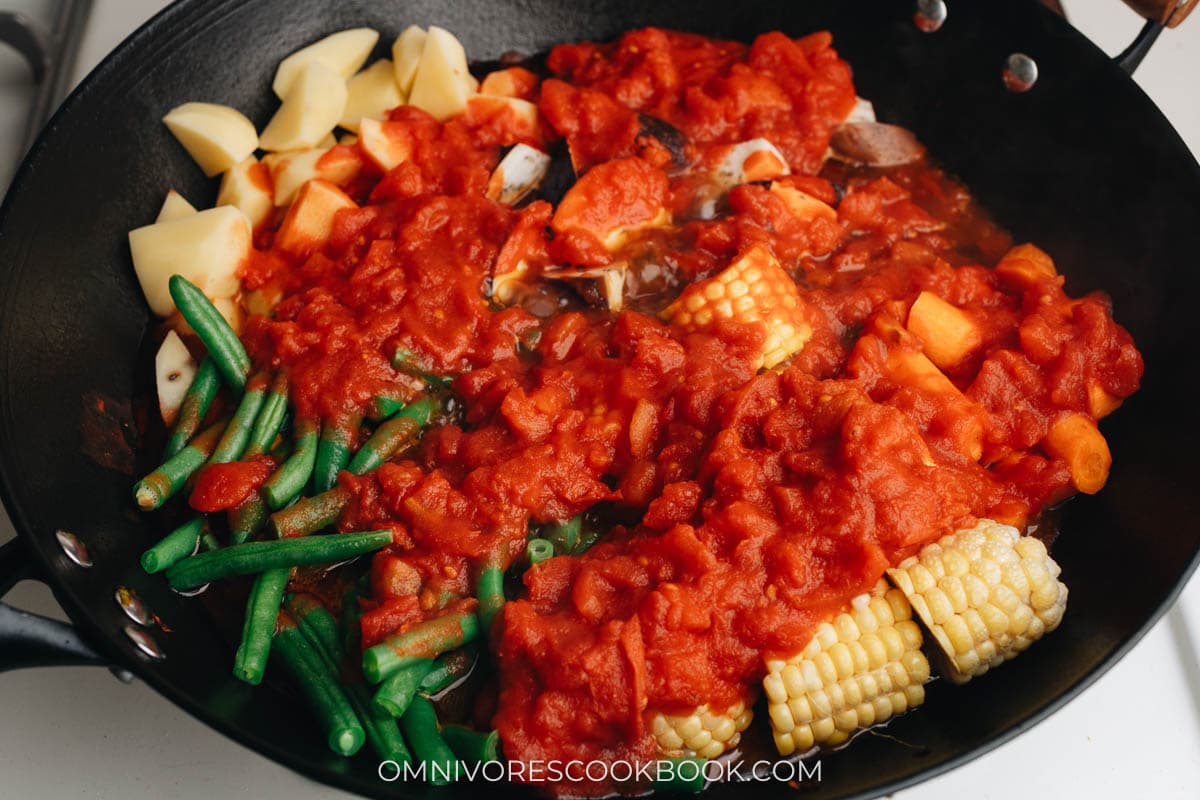
After 5 minutes, uncover the pan and continue cooking until the vegetables turn soft, 15 to 20 minutes.
Once done, the broth will be reduced and thickened a bit, the pork and vegetables very tender and flavorful. Now you can simply top them on rice and enjoy your hearty meal!
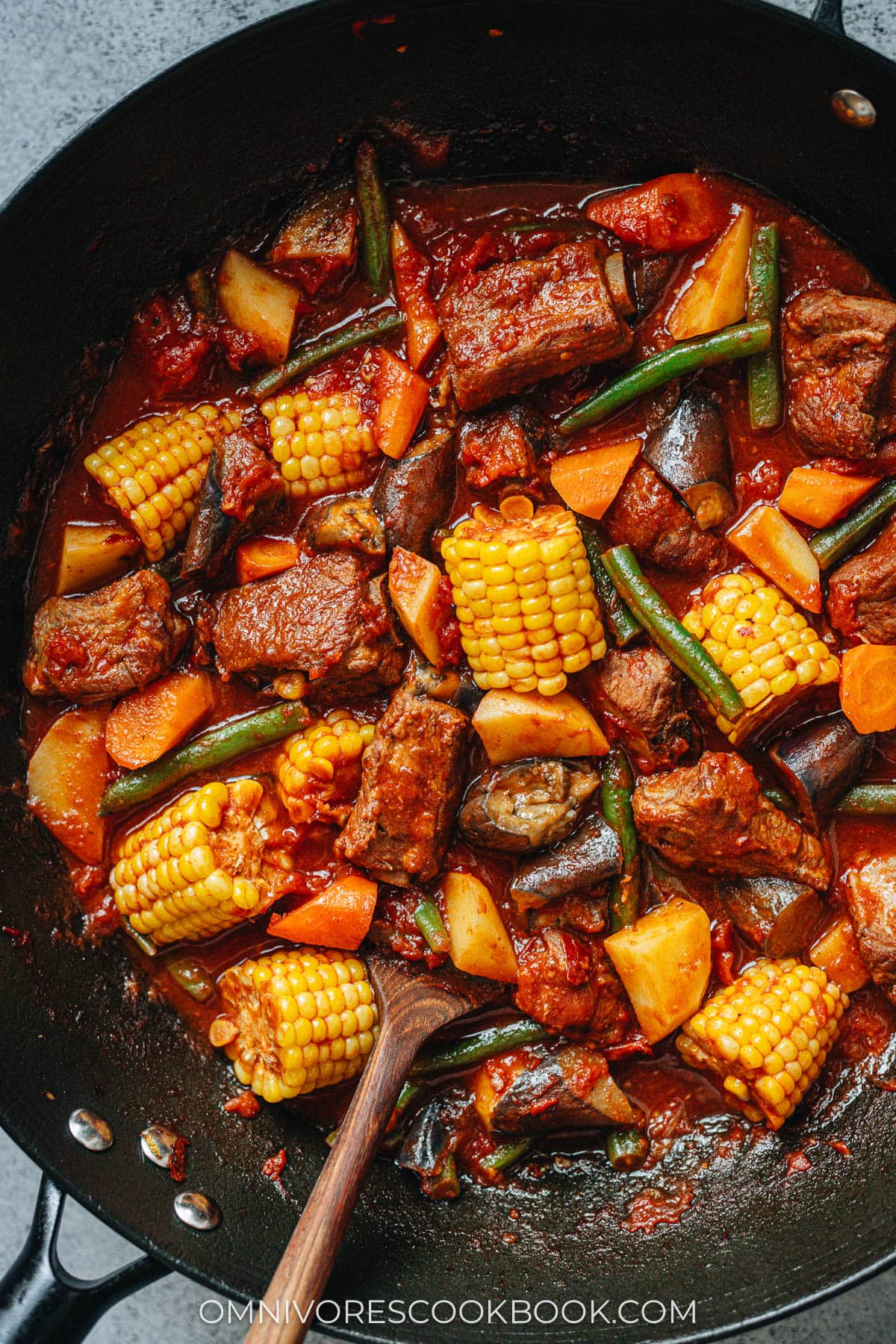
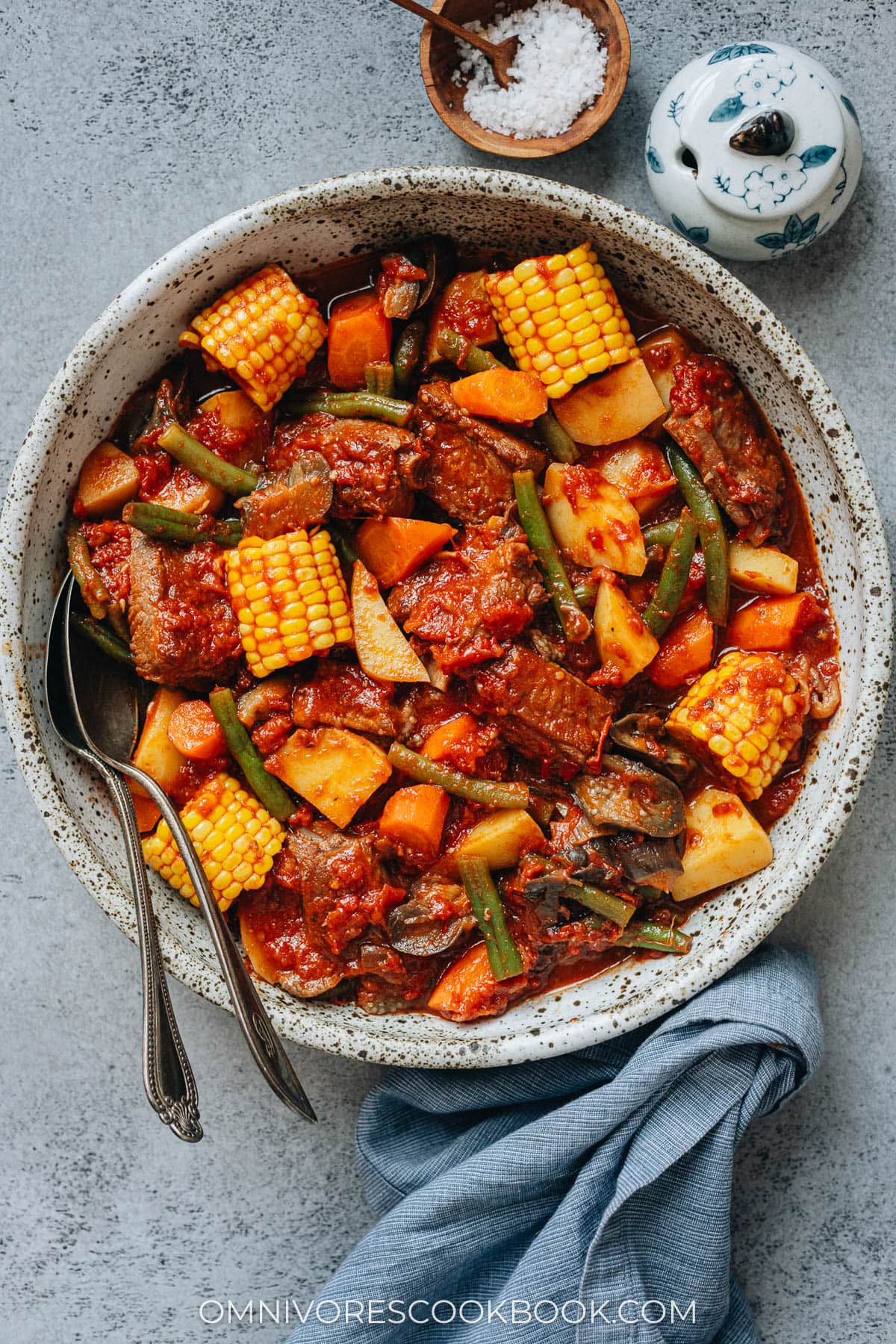
What is the best cookware for pork and vegetable stew?
I used a 14.5” flat bottom wok for this recipe. It’s my favorite pan for this type of dish because:
- It’s very easy to brown meat in it without sticking.
- You can use less liquid to cover all the ingredients due to the shape of the pan.
- It is easier to stir and flip the ingredients.
If a large wok is not available, you can use a large cast iron pot. It is a great alternative to the wok and it creates a great result too.
More Northern Chinese dishes
- Green Bean and Potato Stew (豆角炖土豆)
- Chinese Braised Pork Trotters (红烧猪蹄)
- Chinese Red Braised Lamb (红烧羊肉)
- Lion’s Head Pork Meatballs (狮子头)
- Pork Liver Stir Fry (炒猪肝)
- Pork and Sauerkraut Dumplings (酸菜饺子)
Chinese Cooking Made Easy
Are you new to this website? This free email series is a great place to start. I’ll walk you through a few of my most popular recipes and show you how and why they work. You’ll quickly start to cook better Chinese food in your own kitchen.
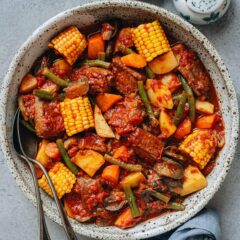
Pork and Vegetable Stew (乱炖)
Ingredients
- 1 to 1.5 lb (450 to 600 g) pork ribs (or pork shoulder, or pork belly) (*Footnote 1)
- 1/4 teaspoon salt
- 1 tablespoon peanut oil (or vegetable oil)
- 2 green onions , sliced to 1/2” (1 cm) pieces
- 4 cloves garlic , smashed
- 1 whole star anise pod
- 1 cinnamon stick
- 2 tablespoons doubanjiang
- 2 tablespoons Shaoxing wine (Optional)
- 2 cups chicken broth (or water)
- 2 tablespoons soy sauce
- 1 tablespoon sugar
- 2 Chinese eggplant , chopped to bite-sized pieces (or 1 regular eggplant) (about 10 oz / 300 g)
- 2 yukon potatoes , chopped to bite-sized pieces (about 1/2 lb / 225 g)
- 1/2 lb (225 g) green beans , tough ends removed and halved crosswise
- 2 big carrots , chopped to bite-size pieces (about 1/2 lb / 225 g)
- 2 ears corn on the cob , cut to 2” (5-cm) long pieces
- 1 can (28-oz.) tomatoes , diced
Instructions
- Sprinkle salt evenly on both sides of pork ribs.
- Heat 1 tablespoon of oil in a large wok (or a 5-qt dutch oven, or a heavy duty pot) over medium heat until hot. Add pork ribs. Brown both sides until golden.
- Add the green onion white part, garlic, star anise, and cinnamon stick. Cook and stir until very fragrant, 2 to 3 minutes.
- Add doubanjiang. Cook and stir until the ingredients are covered evenly, and you can smell a pungent aroma, about 1 minute.
- Pour in the Shaoxing wine and deglaze using a spatula, scraping off any brown bits from the bottom.
- Pour in the chicken broth. Add the soy sauce and sugar. Turn to medium-high heat and cook until brought to a boil. Cover, turn to medium-low or low heat, simmer for 1 hour or so, until the ribs start to turn tender.
- While simmering the pork ribs, prepare and chop the veggies.
- When the pork starts to turn tender, add the potato, carrot, green beans, corn, and eggplant into the pot. Pour the canned tomato over everything. Cover, turn to medium-high heat, and cook until boiling. Turn to medium heat and let braise for 5 minutes, covered. (*Footnote 2)
- Uncover, then stir to mix everything well. Turn to medium heat, braise for another 15 to 20 minutes uncovered, or until the vegetables turn tender. Stir with spatula occasionally, so that all the ingredients are soaked in the sauce and to prevent sticking to the bottom. At the end of cooking, carefully taste the stew and adjust seasoning with salt and sugar, if needed. Serve hot as a main dish with rice, noodles, or bread.
Notes
- I used short pork ribs in the recipe, which are often sold in Chinese markets. You can use many other pork cuts that are suitable for stew, for example, pork shoulder (butt), shank and pork belly.
- It might seem like the pot does not have enough liquid when you just pour the canned tomato over the ingredients. But after 5 minutes of simmering, the vegetables will release a lot of liquid and it will be enough to cover all the ingredients and cook them properly.
Nutrition

Did you make this recipe?
I’d love to hear how it turned out for you! Please take a moment to leave a 5-star rating ⭐️ and share your thoughts in the comments further down the page. It really helps others discover the recipe too.

W
Can you freeze any leftovers?
Maggie Zhu
Yes you can!
Bill the Elder
Well that came out wonderfully well. We have pounds of pork belly since you can only eat it sparingly. I’ve learned that a way to deal with the excess fat is to put it on a smoker, I use a Big Green Egg. I cut it into roughly 3″ chunks and cook it on the grill until the temperature gets to about 165 degrees. I then wrap it in foil and cook it to 195. The fat gets reduced and rendered into the meat. We freeze bunches of it and use it in our favorite Chinese recipes.
Worked like a charm on this one. Also used the Instant Pot. Cut the pre-cooked chunks in half and put them in the pot. Heated them up on saute mode with the aromatics and used the wine to clean up the bottom after everything was smelling wonderful. Added 1 cup chicken broth with the soy sauce and let it cook on slow cook low while I chopped up veggies. Followed the rest of the recipe as written but added some winter squash instead of the corn. Put the IP on pressure cook high for 10 minutes, vented rather than let it naturally aspirate. Put it on some brown rice and it is sooooooo good. Thanks Maggie
Maggie Zhu
So happy to hear you enjoyed the dish! The smoked pork belly sounds amazing. Many Chinese cooks directly use uncooked pork belly in the dish (small quantity) but I still think it’s too fatty. Plus they don’t turn very tender unless you cook them for a long time. The smoked one sounds so much nicer 🙂 Thank you for sharing your experience and leaving a positive review!
Lizard-with-tumour Eater
“Return the pork ribs to the pot”… when did we have to remove the pork from the pot? Mind you, it’s simmering away on the stove as we speak, smelling gorgeous. For lighter eats, it would make a great veg stew too, sans pork. Cheers!
Maggie Zhu
Sorry for the typo! It’s from an old instruction that’s no longer needed (I used to remove all the ribs before saute the aromatics, but then realized it’s not needed).
I do think it makes a veggie stew as well! Will try that out myself next time 🙂
Lizard-with-tumour Eater
It was gorgeous as expected. We voshed in extra veg, but the pork and aromatics were king. Thanks for getting me a new paste! 🙂
Bill the Elder
We are retired farmers and still raise a few hogs and meat sheep for ourselves, family, and friends. We have a large garden and freeze lots of vegetables each fall so this recipe is right up our alley.
Two questions. First do you think this would do well in an Instant Pot and second, since it is from northeastern China would lamb meat work instead of pork?
Maggie Zhu
Yes to both! I think it would work well in an instant pot, but I’d reduce the chicken broth from 2 cups to 1 cup (the liquid won’t evaporate in the IP like on the stove). First brown the lamb, then braise in the IP at high pressure for 30 minutes. Then add the rest (vegetables and canned tomato). Then set at high pressure to cook again, this time 8 to 10 minutes. Use 8 minute if you have more tender vegetables like eggplant, cut any harder vegetables into small bite-size pieces. Or cook for 10 minutes if most vegetables like harder ones like carrots and potato, cut them to larger bite-size pieces.
April
Wonderful base start to Chinese flavours for a vegetarian stew. I did embellish with a bit of fresh ginger and sesame oil
J-Mom
Yummmmmmm. This just smelled great while making. And it is really easy to eat the vegetables. Before I knew it, I finished all my vegetable while 2/3 of a rib meat was still left on my plate. Thank you for the recipe! A totally different (not BBQ) way to eat ribs, too.
Maggie
I know! This is one of the signature northern Chinese dishes that we love the most. There’re lots of ribs in the dish but it’s a vegetable dish. I’m really glad to see you tried out this dish, because it is not very well-known outside of China.
Hope you have a great week ahead 🙂
Helen @ Scrummy Lane
I’m constantly amazed by how many incredible dishes you have in China, Maggie! And I LOVE the name of this. Chaos stew – it’s brilliant!
This looks so beautifully rustic and wholesome, and I love that you’ve figured out how to make the authentic version even more delicious!
Tamara
I love to read your posts Maggie! They are so informative… I do a lot of Asian cooking, and I think I know quite a bit, and then you show me there is so much more to learn! This is a great recipe, and I’m pinning for one of those occasions when I get to try a new recipe. Thanks!
Sophia, Veggies Don’t Bite
I love hot sauce! I pretty much put it in anything. And all those delicious veggies look yum!
Valentina
Wow, this is a gorgeous stew. I didn’t know about the cuisine in Northern China and love learning about it, so thank you for the history. I love rustic, hearty dishes with a ton of flavor and that’s exactly what this seems to be. Delicious!
Sharee @ Savory Spicerack
This looks delicious! I use those tomatoes all the time in my recipes. It makes it very easy when I cook. Thanks for the how to photos in your recipe as it helps tremendously! Yummed!
Robyn @ Simply Fresh Dinners
Wow, Maggie, I’m all about stews and this has got to be one of the best I’ve seen. I love the diverse flavours! My taste buds are craving a bite of this! You have outdone yourself, friend. Both gorgeous looking and a fantastic recipe!
Jolina – The Unlikely Baker
I actually love that it’s called chaos stew! And anything that would help us clean out the fridge is awesome 🙂 Thanks for your very detailed step-by-step instructions. We’ll definitely tag you on insta once we’ve made this!